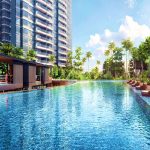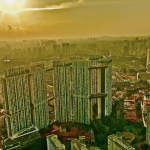While some Singaporeans like their properties shiny and new, another group refuses to buy from a showroom. After being burned from experiences like The Seaview, some buyers only trust what they can see. That’s not a bad idea, but you need to know what to look out for. It’s a lot more complex than just checking price histories:

Image Credits: Reflections by the Bay, Cegoh, Pixabay
A note on properties with 30 years or less remaining on the lease
There is no bank loan available for these properties, and you cannot use your CPF monies to buy them. If you’re dead set on purchasing these old houses, there are two main ways to avoid paying for everything in cash.
The first is to buy the property through your business, if you own one. This can count as a business loan rather than a mortgage, so the usual rules don’t apply. However, business loans have a higher interest rate than mortgage loans.
The second way is to strike a private deal with the seller, in which you agree to pay by instalments. You’ll have to hire a lawyer for these types of deals, to draft the necessary contract. Shop around to find the law firm that’s willing to charge you less.
You should contact one of our mortgage broker at iCompareLoan, to help you out with these unusual cases. For those of you who are not sure what is a mortgage broker, you can read what is a Mortgage Broker here.
The important things to look for
Never rely on pictures or brochures alone. Always view the property in person (this is one of the main advantages of buying a resale), and don’t be afraid to visit multiple times if you feel you have to. Keep an eye out for the following:
- Google the condo name, and look for past articles
- Look up the transaction history
- Check the URA master plan
- Check nearby amenities and their real walking distance
- Check the condition of the facilities
- Drop by the property at different times of days
1. Google the condo name, and look for past articles
Check up on whether there are any stories featuring the condo. Besides alerting you to things like en bloc potential (how many times has the attempt been made?), it will also warn you of any lawsuits involving the management committee. If the management has sued the developer, for example, you should find out why; it could be due to serious structural defects, or facilities that don’t work as promised. You’ll also find out if there’s friction among the neighbours, which is common in the aftermath of things like a failed en-bloc attempt.
2. Look up the transaction history
The property agent should have briefed you on the transaction history. But even then, check the numbers against the Urban Redevelopment Authority’s (URA) website. You can see the recent recorded prices here. Also take note of the rental yield, and how it compares to surrounding properties.
If you’re not sure how to work out the yield, it’s simply (net annual rental income) / (total cost of property) x 100.
So say the annual rental income is $48,000, or about $44,000 after taxes, maintenance, and other costs. The total cost of the property is $1.6 million. The rental yield is $44,000 / $1,600,000 x 100 = 2.75 per cent.
You can then compare the rental yield with the interest rate on your home loan, to see if you are making a decent return (for comparison sake, most “safe” financial investments have a return of three to four per cent per annum, which might make the above example a questionable buy). This should also make it apparent why the home loan interest rate is important. If your rental yield is merely on par with your home loan interest, then your property could be more of a liability than an asset.
Speak to our mortgage experts, who can help you find the lowest interest rate among hundreds of loan packages.
However, remember you need to track the rental yield over a period of at least five years, preferably 10, to get a decent sense of how the property will perform. You can also compare the rental yield with surrounding units, to decide if the price is fair.
Home owners don’t have to worry as much about this as landlords / investors about when is the best time to buy a property. If you intend to use the condo as a home, always pick the one you feel comfortable in, rather than the one with the better transaction history.
3. Check the URA master plan
Always check the URA master plan before you buy. Just because an area seems peaceful now, that may not be the case in the next five years. If there’s going to be an industrial park or airfield nearby, you could see more traffic congestion, and expect to hear drilling or planes all through the afternoon.
Likewise, some condos may seem devoid of amenities; but if there’s a mega-mall springing up nearby, it may be worth tolerating the temporary inconvenience. There could be significant room for price appreciation, as was the case when Serangoon Nex sprang up in a previously “ulu” location.
4. Check the nearby amenities and their real walking distance
Many brochures advertise things like “five minutes walk to the MRT”. Remember that these statements are all subjective. A 50 year old smoker who has to walk uphill, to get to the MRT station, will take much longer than a fit 25 year-old. If you have family members who are less mobile, ensure the journey is manageable for them. Sometimes the bus or train station might be close by, but getting there involves going up a steep incline, or having to cross a major road (bad if you have young children).
Also, check that the amenities are really the sort you can use. There’s no point having a chain of $60-per-head restaurants nearby (e.g. Duxton Hill), if what you consider an amenity is cheap hawker fare. Likewise, the nearby retail outlets may not appeal to you. The shops in your former HDB flat may be well catered to day-to-day needs, whereas the retail outlets near a condo may be more boutique. Are you really enticed by three watch shops and a scented candle store in the nearby mall?
5. Check the condition of the facilities
See if the gym has missing or rusted equipment, and check that the pool isn’t a filthy, toxic sludge. It’s amazing how much damage a few years of incompetent management can do. The best condos are the ones that haven’t just maintained the facilities, but added on to them. Don’t forget to check on the lifts especially, as constant lift breakdowns are one of the most common headaches.
Also check if the facilities are easy to use! In some crowded condos, for example, BBQ pits have to be booked a month in advance; and there’s almost no chance of getting one on long weekends. Likewise, some condos have clubhouses that require you to go on epic quests, just to book them for a birthday party. We know of at least one estate where booking a clubhouse room takes two months’ notice, and every guest needs an ID tag.
6. Drop by the property at different times of day
A common mistake is to view the property only once. Do try to visit at least one more time, at a different hour of the day. You’ll want to know if the neighbours scream at each other, when they’re home from work at night. You’ll also want to know if the living room is baking hot, by the time it’s one o’clock.
If you drive, view the place at least once near peak-hour. This will give you a sense of how bad the congestion when be, when you’re headed home from work.






